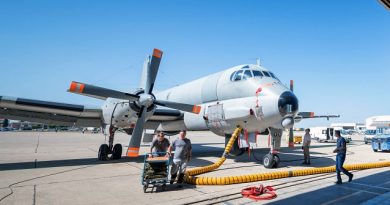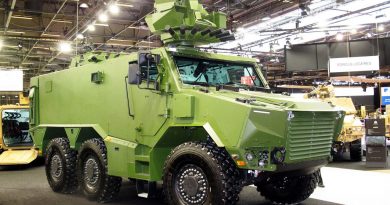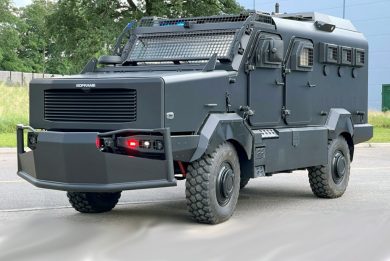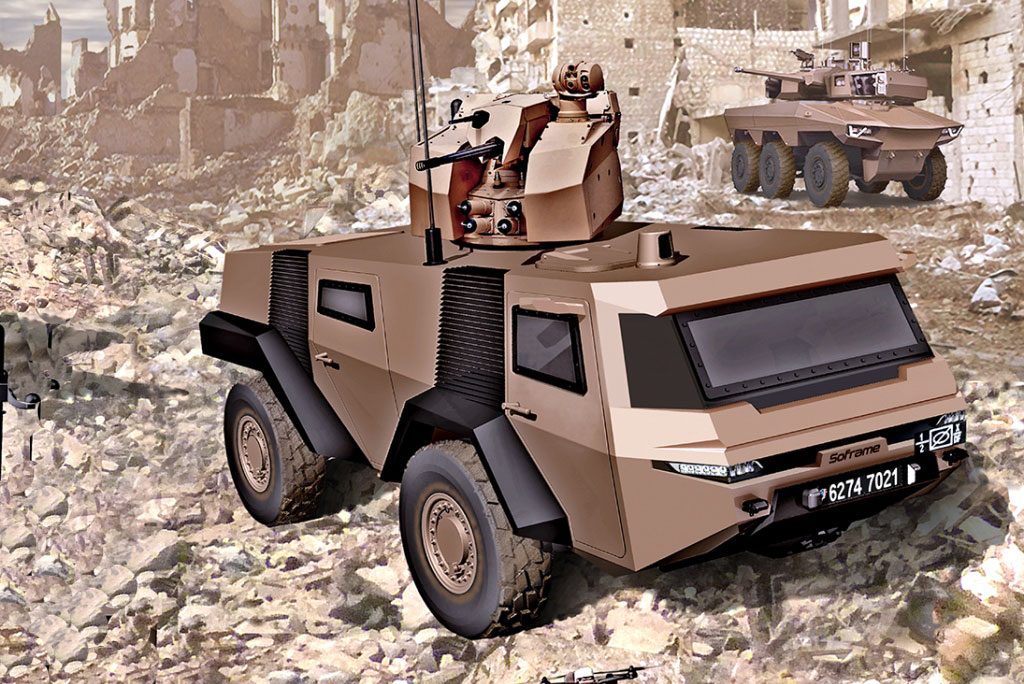
SOFRAME details its MOSAIC recce vehicle, aiming at the French Army VBAE programme but not only
By Paolo Valpolini
To younger people involved in defence the name Lohr might not mean much, however in the past that French company designed and developed some among the most innovative designs seen at land defence exhibitions. Its name is definitely linked to the FL500/501, FL standing for Fardier Lohr, a mechanical mule adopted by the then French 11th Parachute Division, as well as by Spanish Boinas Negras and by the Tunisian Army. The Lohr brand has disappeared for quite some time from defence exhibitions, however SOFRAME, which is part of the Lohr group, continued to operate in that field. Mostly involved in the area of logistic vehicles, such as transport and recovery systems, semi-trailer tank transporters and logistics trailers, it however also developed and produced armoured vehicles, mostly sold on the export market.
Not forgetting one of its best sellers, the company is currently working on a robotised mule financed under the RAPID (Régime d’APpui à l’Innovation Duale) scheme, the French DGA scheme that supports dual-use innovation.
Recently another programme aimed at the French Army emerged; on February 5th 2021 a SOFRAME press release announced the company launch of the MOSAIC development, which aims at proposing a solution for the future VBAE (Véhicule Blindé d’Aide à l’Engagement) that should in due time replace French Army VBLs. EDR On-Line talked to Mr. Patrick Bourreau, the company General Manager, who highlighted some of the vehicle peculiarities.
“After a long time working under wrap we decided to come to the light,” he explains, adding that his company maintains in the DNA the development of alternative concepts to answer new requirements. Known as MOSAIC, the acronym for Mission Observation Surveillance Acquisition Investigation Combat (observation, surveillance, acquisition, intelligence and combat mission) the new vehicle has a 4×4 configuration, its Gross Vehicle Weight being between 7 and 8 tonnes, with a payload capacity of 1.5 tonnes. “While the MOSAIC is born out of the French Army need for a VBL replacement, which requirements are not yet frozen, we are also looking at a product that might be proposed with good chances of success on the international market,” Bourreau says, the company proposing for the time being three different configurations, reconnaissance and intelligence gathering, direct fire, and antitank missile teams transport.
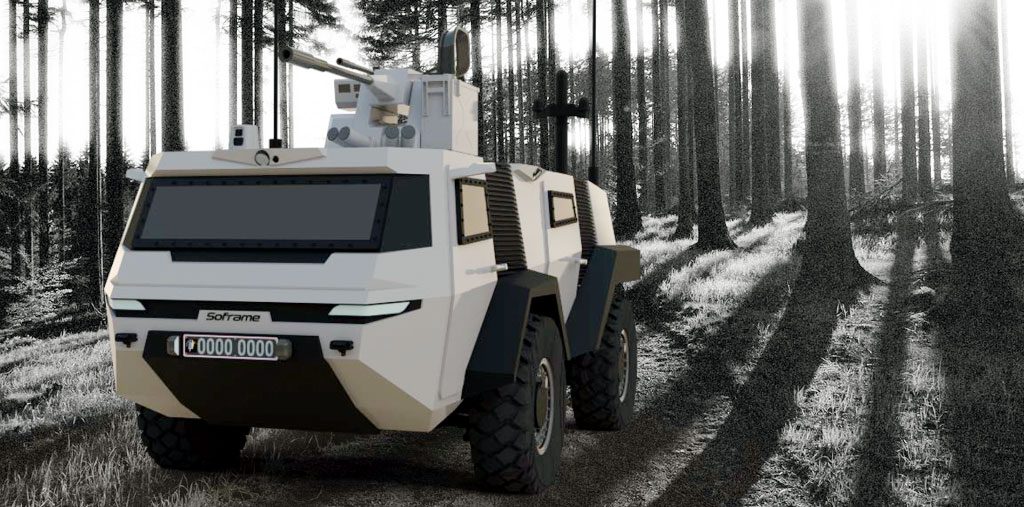
“Trying to find innovative processes, we looked in the past years through biomimicry trying to find nature-inspired solutions, and we considered arthropods, which are very weak inside, their strength being provided by the exoskeleton rigidity, so we choose for our armoured vehicles self-supporting hull solutions, which led us to develop new materials,” the company general manager told EDR On-Line. The Lohr group cooperated with steel producers Industeel and SSAB to develop a 600 brinell steel, this very high hardness material ensuring the baseline protection for its armoured vehicles. Not only, the R&D also looked at composite materials, developing Tenexium, based on an original composition of compressed high-tenacity fabrics, which replaces aramid-based products in many uses, among which i.e. spall liners. “We created a subsidiary, called Tenexium, which is in charge of producing and marketing this material not only for armoured vehicles use. The beauty of Tenexium is that it is insensible to humidity as well as to UV rays, it is not toxic, even when affected by fire, and its performances are maintained for some decades, while aramid-based fabrics degrade after about seven years,” Mr. Bourreau explains, adding that the material can also be easily recycled. The only negative point is that it is slightly heavier than current aramidic products however, at least in the use on SOFRAME armoured vehicles, this is well compensated by the use of the aforementioned high strength steel. The final point is pricing, Tenexium costing about half of current aramid-based products. EDR On-Line understood that the maximum protection level that will be proposed for such a light vehicle will be Level 4, that is 14.5×114 mm armour piercing round at 200 meters
Beside new material, SOFRAME also adopted a wholly new design for antimine/IED underbelly protection; usually the “V” shape floor is oriented along the length of the vehicle. In the MOSAIC we find three “V” oriented along the width; one is ahead of the front axle, one between the two axles, and one behind the rear axle. The central “V” shape is clearly visible between the two axles, the black grids located over the wheels (that are part of the ballistic protection solution) hiding the “chimneys” through which most of the explosion overpressure is vented, the SOFRAME general manager explains.
The MOSAIC will have a crew of two hosted in the front cabin, accessible through two side doors. A wide single-panel armoured glass constitutes the windshield, two transparents being present in the doors to allow lateral view. “It is possible that in further iterations we will slightly reduce the windshield surface,” Patrick Bourreau told us; apparently the French Armée de Terre aims at a 7 tonnes vehicle, hence the need to spare some weight, the growth potential being available for possible export solutions. Although no data was released, the design being far from frozen, considering the weight and a power-to-weight ration of at least 25 hp/t, the diesel engine which will constitute the initial choice should have an output of around 200 hp; the MOSAIC is however designed to be easily fitted with a hybrid propulsion system, to be adopted at a later stage, an electric machine adding its power to that of the internal combustion engine. Not only this will improve mobility, thanks to add on acceleration performances due to the immediately available maximum torque typical of electric machines, but it will provide the MOSAIC with two capabilities of key importance for a recce vehicle: that of moving silently at slow speed in the final approach to the operational area, exploiting only the electric power, and that of having a consistent on-board power generation and power storage capacity, allowing it to carry out long silent watch missions with the ICE engine off, hence reducing thermal and acoustic signature. The optional hybrid mode will also facilitate the transformation of the MOSAIC in an optionally piloted vehicle, tele-operation or autonomous operation being an option in some phase of an operation.
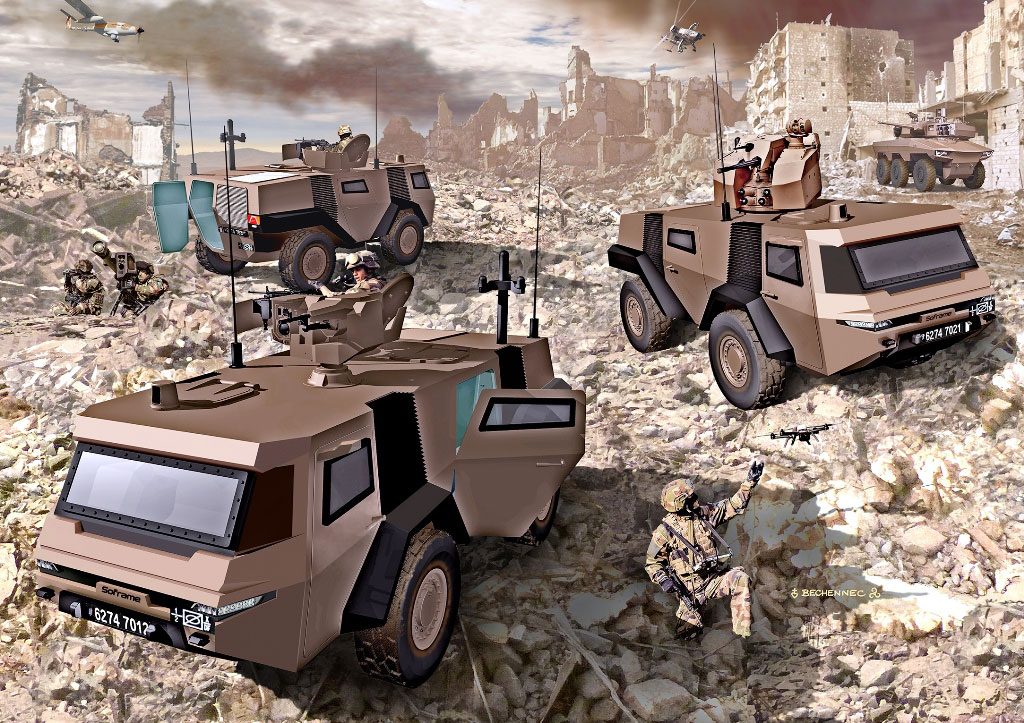
As said SOFRAME initial proposal includes three different variants. The one mostly suited for the VBAE role is the reconnaissance and intelligence gathering version; this will have a two-man crew in the front cabin, with a third manning the sensors located in the centre section, to which access is provided by two side doors. “The engine is located rear right,” Mr. Bourreau explains, “but there is a space on the left side dedicated to mission kits, a hatch in the roof allowing to install i.e. a mast mounted sensor without major modifications to the vehicle.” As for the rear door, he explains that it is mainly designed to allow access to mission kits, however it can be used in case of emergency as an escape door. SOFRAME is obviously considering integrating in its vehicles unmanned vehicles, both air and ground, therefore the roof hatch and the rear door might become obvious openings to launch and recover them. The direct fire version will also have a three-man crew, the maximum firepower considered being that of a RWS armed with a 30 mm low-recoil cannon, firing 30×113 mm ammunition. Finally the antitank missile teams transport version will be the only one to host four military, the two-man crew and the two-man firing team serving MBDA’s MMP (Missile Moyenne Portée), the 5th generation system recently adopted by the French Army, two missiles being carried plus the firing post.
Looking at French Army requirements, SOFRAME considered easy integration of sensors and systems developed within the Scorpion programme framework, such as the Atos SIC-S battle management system, the Metravib SLA acoustic shotgun detector, the Thales Antares 360° vision system, with its integrated laser warning function and future incoming missile detection, and possibly the T1 or T2 RCWS developed by Arquus. The open architecture adopted will however allow easy integration of other third-party systems, a key feature both for spiral upgrades as well as for adapting the vehicle to export customers’ requirements.
The company is currently refining the design and awaits the French Army to freeze its requirements and the DGA to launch the VBAE programme. “We will wait before starting building a prototype,” SOFRAME general manager said, “not only because of the need to have some more detailed and stabilised requirements, but also because a European cooperation is sought for this programme, hence we will have to partner with some foreign company before starting the final leg of the journey. However we proved in the recent past that we are able to step from computer screens to a working prototype in around six months, and we count on our proved industrial capacity as a further asset that potential customers will consider. Not long time ago we managed to produce two vehicles per day for an export customer,” Patrick Bourreau concluded.
Images courtesy SOFRAME

